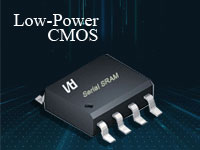MRAM development gains momentum
MRAM is a promising replacement for SRAM, DRAM and flash that are facing serious scaling challenges as the industry moves to smaller nodes.
MRAM has been in development since the 1990s. It is one of a group of several emerging technologies that have been considered candidates for next-generation memory to replace the semiconductor industry’s stalwarts such as DRAM and NAND flash that are facing serious scaling challenges as the industry moves to smaller nodes.
Thus, California-based Spin Transfer Technologies (STT) has announced that it has delivered samples of its spin transfer torque MRAM to unidentified customers in North America and Asia.
The delivery of samples by a chip vendor to potential customers is a standard procedure in the semiconductor industry and STT last year announced publicly that it would begin sampling in the first quarter of this year. However, this announcement carries some significance for several reasons.
First, MRAM has long held promise as a replacement for SRAM, DRAM and flash, but to date only one company, Everspin Technologies, has shipped working MRAM product. Everspin first started shipping MRAM when it was still part of Freescale back in 2006 and claims to have shipped more than 60 million MRAM devices. Last August, Everspin became the first vendor to announce it was sampling MRAM with perpendicular magnetic tunnel junctions (pMTJs), considered by all vendors developing MRAM to offer the best scalability, shape dependence and magnetic scalability.
STT said its samples feature 80nm pMTJs. The company has previously said it has created pMTJs as small as 20nm at its Fremont development fab, among the smallest ever reported.
STT MRAM cost-performance chart (cr)Figure 1: STT's MRAM hierarchy based on cost/performance.
Other significant thing about the STT sampling announcement is that STT is a start-up and one of a handful of firms developing MRAM. The delivery of samples—which STT stressed are “fully functional”—is an important proof point validating STT’s technology, which (to get deeper into the tech jargon) it refers to as orthogonal spin transfer MRAM.
“They are putting something out for other people to work with. That’s always a pretty significant thing for a company to do,” said Tom Coughlin, a veteran memory analyst and founder of consulting firm Coughlin Associates. He added that samples could “make or break” a company, depending on their performance.
Finally, the delivery of fully functional samples is one more piece of evidence that momentum around MRAM is growing.
”There are lots of things going on in MRAM right now,” Coughlin said. Big firms such as Samsung, Toshiba and Qualcomm all have significant activity around MRAM, he added. Non-volatile memory in general is being increasingly considered as a replacement for volatile memory in a wide spectrum of applications.
MRAM development
Jim Handy, principal analyst with Objective Analysis, told EE Times that there is interest around using MRAM to replace SRAM in some applications, but that for other applications the higher cost of MRAM makes it less appealing.
”I think the real reason that these emerging memory technologies [like MRAM] are getting a lot of attention is because of Intel’s 3D Xpoint announcement,” Handy said. According to Handy, Xpoint creates the need for a new memory layer.
While Coughlin believes MRAM could possibility be a long-term successor to DRAM, he sees it in the short term as an augmentation for DRAM and as a replacement for memory in applications where the non-volatility adds a lot of value.
“There are definitely applications where a little bit of MRAM have a lot of value,” Couglin said. He added that the cost of MRAM will decline as manufacturing volume increases, making it a more attractive option for more applications.
MRAM’s momentum has been steady over the past year as hopes have grown that the development of the technology and market needs may finally be synching up. Last year, Everspin completed a successful IPO.
In addition to STT, there are a handful of other start-ups with MRAM in development, including Avalanche Technology, also headquartered in Fremont. In addition, a number of other firms, including major companies like IBM, Intel, Samsung, Fujitsu, Hynix, Qualcomm, Renesas and Toshiba, have MRAM development of some form or another.
In a document filed in preparation for its IPO last year, Everspin estimated that the market opportunity for MRAM would grow at a compound annual growth rate of 19% from 2015 through next year, reaching $1.8 billion.
STT is still a ways away from commercial products. The company’s goal is to begin shipping devices next year.
Barry Hoberman, STT’s CEO, said in an interview with EE Times that the samples represent a culmination point of investment, development and success in a bunch of different technology areas.
”We have a long, complicated development program here and we certainly aren’t at any end point,” Hoberman said. “These samples are indicative of having completed the first several heats successfully.”
Hoberman said MRAM is gaining momentum and that the company is fielding interest from multiple application areas, mostly places where MRAM’s efficiency make it more attractive than flash, especially for battery powered devices. He added that these applications mostly fall into what is generally classified as the IoT.
Keywords:sram
CONTACT US
USA
Vilsion Technology Inc.
36S 18th AVE Suite A,Brington,Colorado 80601,
United States
E-mail:sales@vilsion.com
Europe
Memeler Strasse 30 Haan,D 42781Germany
E-mail:sales@vilsion.com
Middle Eastern
Zarchin 10St.Raanana,43662 Israel
Zarchin 10St.Raanana,43662 Israel
E-mail:peter@vilsion.com
African
65 Oude Kaap, Estates Cnr, Elm & Poplar Streets
Dowerglen,1609 South Africa
E-mail:amy@vilsion.com
Asian
583 Orchard Road, #19-01 Forum,Singapore,
238884 Singapore
238884 Singapore
E-mail:steven@vilsion.com
